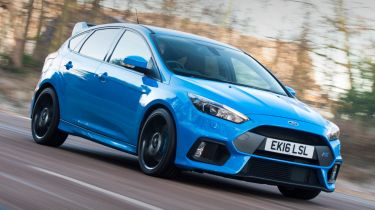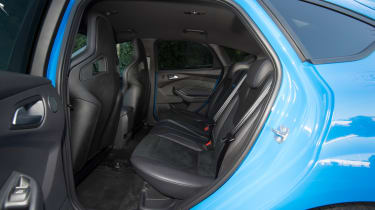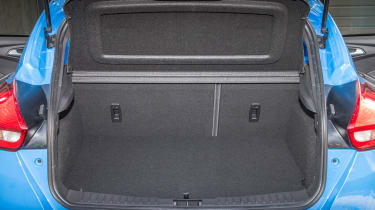Ford Focus RS (2016-2018) review - Practicality, comfort and boot space
The Focus RS is practical for a sports car, but fast hatch rivals have more space inside

Like the standard Focus, the RS model isn’t the roomiest hatchback around. However, performance is a greater priority in a car like this, so buyers will be happier to overlook its smaller carrying capacity compared to its rivals.
The boot has less space than you’ll find in an Audi RS3 or VW Golf R, but at least the standard five-door body means it’s easy to access the back seats, while those in the front have plenty of room and a wide range of wheel and seat adjustment to get comfortable.
The standard Recaro sports seats are a bit bigger than normal, so legroom in the back is slightly reduced, although if you're looking at a car with the upgraded Recaro shell front seats this helps create some room - but some might find them a bit uncomfortable. Plus their large and solid backrests hinder the view forward for passengers sitting in the rear.
Whichever seats you choose, you’ll find that you feel like you’re sitting rather high in the Focus’ cabin. The seats don’t adjust low enough for some tastes, and makes you feel like you’re sitting on the car, rather than in it. Aside from the seats, the rest of the RS’s cabin is the same as the standard Focus, so you get decent door bins, a deep armrest cubby and a big glovebox.
Size
In terms of dimensions, the RS is the same size as the standard Focus. That means it’s similar in size to rivals such as the VW Golf R and Audi RS3, but slightly bigger than the Mercedes A 45.
Used - available now

2025 Audi
Q2
15,384 milesAutomaticPetrol1.5L
Cash £25,500
2020 Vauxhall
Grandland X
26,500 milesManualPetrol1.2L
Cash £11,287
2023 Volkswagen
Touareg
30,318 milesAutomaticDiesel3.0L
Cash £40,087
2019 Mercedes
GLC
20,296 milesAutomaticPetrol2.0L
Cash £22,087Its five-door body means access is pretty easy, while the thin pillars help visibility out, too. The lower chin spoiler and an overall lower ride height than the standard Focus means you’re more likely to scrape over speed bumps, especially as the stiff suspension doesn’t offer any give over bumps.
The steering is fast and precise to make the most of incredible grip, but there’s not much lock. Fat tyres also sniff out cambers, so the Focus needs guidance on rough roads.
Leg room, head room & passenger space
Space for back seat passengers is limited when compared to models like the VW Golf R and Audi RS 3. There’s just about room for three across the back, although the middle seat is higher than the two on either side, and legroom is even more restricted thanks to the transmission tunnel running to the back of the car. Like the standard Focus, the RS has two sets of Isofix points in the outer rear seats. Headroom is fine in the Focus RS, although the £575 sunroof can cut headroom slightly.
Space up front is good, and while the Recaro sports seats are mounted on the high side, headroom is fine. The heavily bolstered seats hold you in place in corners, but they’re still comfortable in everyday use, but the optional Recaro shell seats are firmer, so try before you buy. These were around £1,200 to upgrade, and while they’re brilliantly supportive, they seat you too high in the cabin, compromising the driving position. They do boost legroom in the back, though.
Boot
There’s a four-wheel-drive system underpinning the Focus RS, and accommodating the rear differential has resulted in a smaller boot than the standard car – already one of the most cramped in the family car class. With the seats in place there’s a paltry 260 litres to play with, which is less than you’ll get in a Fiesta supermini. In comparison, the VW Golf R has a smaller boot than the standard car, but at 343 litres it’s still 83 litres up on the Focus RS.
While it’s not big, the Focus RS’s boot is a decent shape, with a large floor and no intrusion from the wheelarches or suspension. It also has a shallow boot lip and a wide opening. At least a 60/40 split fold rear seat is standard, and with the rear bench lowered there’s a reasonable 1,045 litres on offer. However, you need to flip the seat bases up if you want a flatter floor. The seats are released via a pair of shoulder-mounted buttons, and they are easy to fold, while the parcel shelf is easy to remove, too.









